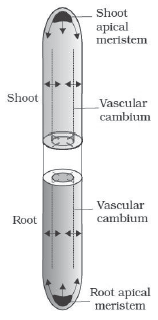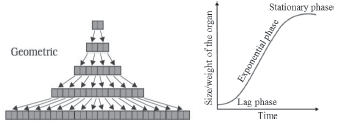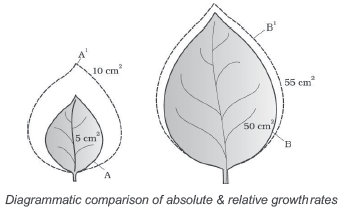Please see Plant Growth and Development Class 11 Biology Revision Notes provided below. These revision notes have been prepared as per the latest syllabus and books for Class 11 Biology issues by CBSE, NCERT, and KVS. Students should revise these notes for Chapter 15 Plant Growth and Development daily and also prior to examinations for understanding all topics and to get better marks in exams. We have provided Class 11 Biology Notes for all chapters on our website.
Chapter 15 Plant Growth and Development Class 11 Biology Revision Notes
All plant cells are descendants of the zygote (fertilized egg). The zygote develops into a mature plant through growth and differentiation forming roots, leaves, branches, flowers, fruits and seeds. Then they eventually die.
GROWTH
♦ Growth is an irreversible permanent increase in size of an organ or its parts or an individual cell.
♦ It involves metabolic processes that consume energy.
Plant Growth Generally is Indeterminate
♦ Plant growth continues throughout the life due to the presence of meristems.
♦ Meristematic cells have capacity to divide & selfperpetuate.
♦ The growth where new cells are always added to the plant body by the meristem is called open form of growth.

♦ Primary growth: It occurs due to root apical meristem & shoot apical meristem. It causes the elongation of the plants along the axis.
♦ Secondary growth (In gymnosperms & dicots): It occurs due to lateral meristems, vascular cambium & cork-cambium. It causes increase in the girth of organs.
Growth is Measurable
♦ At cellular level, growth occurs due to increase in the amount of protoplasm.
♦ Increase in protoplasm is difficult to measure directly. So growth is measured by parameters like increase in fresh weight, dry weight, length, area, volume & cell number. E.g.
Cell number: E.g. A maize root apical meristem can produce more than 17,500 new cells per hour.
Cell size: E.g. Cells in a watermelon can increase in size by up to 3,50,000 times.
Length: E.g. Growth of a pollen tube.
Surface area: E.g. Growth in a dorsi-ventral leaf.
Phases of Growth
3 phases: meristematic, elongation & maturation.
1. Meristematic phase: It occurs in the meristems at the root apex & the shoot apex. Here, cells have rich protoplasm and large nuclei. Cell walls are primary, thin & cellulosic with abundant plasmodesmata.
2. Elongation phase: It occurs in cells proximal (just next, away from the tip) to the meristematic zone. The cells have increased vacuolation, size and new cell wall deposition.
3. Maturation phase: It occurs in the cells further away from the apex, i.e., more proximal to the phase of elongation. The cells attain maximal size in terms of wall thickening and protoplasmic modifications.

Growth Rates
♦ It is the increased growth per unit time.
♦ The growth rate may be arithmetic or geometrical.
Arithmetic growth:
♦ In this, following mitotic division, only one daughter cell continues to divide while the other differentiates & matures.
♦ On plotting the length of the organ against time, a linear curve is obtained.

Mathematically, it is expressed as Lt = L0 + rt
Lt = length at time ‘t’
L0 = length at time ‘zero’
r = growth rate / elongation per unit time.
Geometrical growth:
♦ Here, both daughter cells continue mitotic cell division.
♦ In most systems, the initial growth is slow (lag phase), then it increases rapidly (log or exponential phase).
♦ If nutrient supply is limited, the growth slows down leading to a stationary phase.
♦ On plotting the parameter of growth against time, we get a typical sigmoid (S) curve.
♦ A sigmoid curve is a characteristic of living organism growing in a natural environment. It is typical for all cells , tissues and organs of a plant.


♦ Here, r is relative growth rate. It is also the measure of ability of plant to produce new plant material (efficiency index). Hence, final size W1 depends on initial size, W0.
♦ Quantitative comparisons between the growth can also be made in 2 ways:
(i) Absolute growth rate: Measurement & comparison of total growth per unit time.
(ii) Relative growth rate: Measurement of growth of the given system per unit time expressed on a common basis, e.g., per unit initial parameter.

Conditions (essential elements) for Growth
1. Water: Essential for cell enlargement. Turgidity of cells helps in extension growth. Water provides medium for enzymatic activities needed for growth.
2. Oxygen: It helps to release metabolic energy for growth.
3. Nutrients: Macro & micro elements are needed for the synthesis of protoplasm and act as source of energy.
4. Temperature: At optimum temperature, growth is maximum. Deviation from this may harm the plants.
5. Light & gravity: Affect certain phases/stages of growth.
DIFFERENTIATION, DEDIFFERENTIATION & REDIFFERENTIATION
♦ Differentiation is the process in which the cells in meristems (root apical & shoot-apical) and cambium differentiate and mature to perform specific functions.
♦ In this, cell walls & protoplasm undergo major structural changes. The capacity of cell division is lost.
E.g. Loss of protoplasm to form a tracheary element. They also develop very strong, elastic, lignocellulosic secondary cell walls to carry water to long distances even under extreme tension.
♦ Under certain conditions, living differentiated cells regain the capacity of division. This is called dedifferentiation. E.g. formation of meristems (interfascicular cambium & cork cambium) from differentiated parenchyma cells.
♦ The dedifferentiated cells can divide and produce cells that again lose the capacity to divide but mature to perform specific functions. It is called redifferentiation.
♦ Plant growth is open, i.e., it can be indeterminate or determinate. Differentiation in plants is also open, because cells/tissues arising out of the same meristem have different structures at maturity.
♦ Final structure at maturity of cell/tissue is also determined by the location of the cell.
E.g. cells positioned away from root apical meristems differentiate as root-cap cells, while those pushed to the periphery mature as epidermis.
DEVELOPMENT
♦ It is a process that includes all changes in the life cycle of an organism from seed germination to senescence.
♦ It is the sum of growth and differentiation.

♦ Plants follow different pathways in response to environment or phases of life to form different kinds of structures. This ability is called plasticity. E.g.
Heterophylly due to phases of life: E.g. In cotton, coriander and larkspur, the leaves of the juvenile plants and mature plants are different in shape.
Heterophylly due to environment: E.g. Difference in shapes of leaves produced in air and water (e.g. buttercup).

Factors controlling the development:
Intrinsic factors: Include intracellular (genetic) or intercellular factors (such as plant growth regulators).
Extrinsic factors: Include light, temperature, water, oxygen, nutrition, etc.
PLANT GROWTH REGULATORS (PLANT HORMONES OR PHYTOHORMONES)
Plant growth regulators (PGRs) are small, simple molecules that regulate plant growth.
Based on the functions, PGRs are 2 groups:
♦ Plant growth promoters: For growth promoting activities like cell division & enlargement, tropic growth, pattern formation, flowering, fruiting & seed formation. E.g. auxins, gibberellins and cytokinins.
♦ Plant growth inhibiters: For growth inhibiting activities like dormancy & abscission. Respond to wounds & stresses of biotic and abiotic origin.
E.g. abscisic acid & ethylene. (Ethylene fits either of the groups, but it is largely a growth inhibitor).
1. Auxins
♦ Charles Darwin & his son Francis Darwin observed that the coleoptiles of canary grass responded to unilateral illumination by growing towards the light source (phototropism). It was concluded that the tip of coleoptile caused the bending of the entire coleoptile.

♦ F.W. Went isolated Auxin (Greek ‘auxein’: to grow) from tips of coleoptiles of oat seedlings.
♦ Auxin was first isolated from human urine.
♦ Auxins are produced by the growing apices of stems & roots, from where they migrate to regions of their action.
Types of Auxins:
1. Natural: E.g. Indole-3-acetic acid (IAA) and indole butyric acid (IBA). They are isolated from plants.
2. Synthetic: E.g. NAA (naphthalene acetic acid) and 2, 4- D (2, 4-dichlorophenoxyacetic).
Functions of auxins:
♦ Initiate rooting in stem cuttings for plant propagation.
♦ Promote flowering. E.g. in pineapples.
♦ Prevent fruit and leaf drop at early stages.
♦ Promote the abscission of older leaves and fruits.
♦ Induce parthenocarpy. E.g., in tomatoes.
♦ Used as herbicides. E.g. 2, 4-D is used to kill dicot weeds. It does not affect mature monocot plants. It is used to prepare weed-free lawns.
♦ Controls xylem differentiation and helps in cell division.

In higher plants, the growing apical bud inhibits the growth of lateral (axillary) buds. It is known as apical dominance. Removal of shoot tips (decapitation) results in the growth of lateral buds. It is applied in tea plantations & hedge-making.
2. Gibberellins
♦ These are acidic PGR.
♦ E. Kurosawa treated the sterile filtrates of Gibberalla fujikuroi (a fungus that causes ‘bakane’ disease or foolish seedling in rice) to healthy rice seedlings. As a result, it showed the symptoms of ‘bakane’ disease. Later, the active substances were identified as gibberellic acid.
♦ There are more than 100 gibberellins (GA1, GA2, GA3 and so on) in fungi and higher plants.
♦ Gibberellic acid (GA3 or Terpenes) is one of the first discovered and most intensively studied gibberellins.
Functions:
♦ They cause an increase in length of axis. So they are used to increase the length of grapes stalks.
♦ To elongate and improve the shape of fruits such as apple.
♦ They delay senescence. So the fruits can be left on the tree to extend the market period.
♦ GA3 is used to speed up malting process in brewing industry.
♦ Sugarcane stores sugar in stems. Spraying sugarcane crop with gibberellins increases the length of the stem. It increases the yield by as much as 20 tonnes per acre.
♦ Spraying juvenile conifers with GAs hastens the maturity period. It leads to early seed production.
♦ For bolting (internode elongation just prior to flowering) in beet, cabbages and many plants with rosette habit.
3. Cytokinins
♦ F. Skoog and co-workers observed that from the internodal segments of tobacco stems, the callus (a mass of undifferentiated cells) proliferated only if the nutrients medium was supplemented with extracts of vascular tissues, yeast extract, coconut milk or DNA. Skoog & Miller later identified and crystallized the active substance and termed as kinetin.
♦ Cytokinins were discovered as kinetin (N6-furfurylamino purine – an Adenine derivative) from the autoclaved herring sperm DNA.
♦ Kinetin does not occur naturally in plants.
♦ Zeatin (from corn-kernels and coconut milk) is the natural substances with cytokinin-like activities.
♦ There are some synthetic compounds with cell division promoting activity.
♦ Natural cytokinins are synthesized in regions of rapid cell division (root apices, shoot buds, young fruits etc).
Functions:
♦ Play a role in cytokinesis.
♦ Help to produce new leaves, chloroplasts in leaves, lateral shoot growth and adventitious shoot formation.
♦ Help overcome the apical dominance.
♦ Promote nutrient mobilization which helps in the delay of leaf senescence.
4. Ethylene (C2H4)
♦ Cousins confirmed that ripened oranges released a volatile substance that hastened the ripening of stored bananas. Later this substance was identified as ethylene.
♦ Ethylene is a simple gaseous PGR.
♦ It is synthesized in large amounts by tissues undergoing senescence and ripening fruits.
Functions:
♦ Influences horizontal growth of seedlings, swelling of the axis and apical hook formation in dicot seedlings.
♦ Promotes senescence and abscission of plant organs especially of leaves and flowers.
♦ Promotes fruit ripening. It enhances respiration rate during fruit ripening. This is called respiratory climactic.
♦ Breaks seed and bud dormancy, initiates germination in peanut seeds, sprouting of potato tubers.
♦ Promotes rapid internode/petiole elongation in deep water rice plants. It helps leaves/upper parts of the shoot to remain above water.
♦ Promotes root growth and root hair formation. It increases absorption surface.
♦ Used to initiate flowering and for synchronising fruit-set in pineapples. It also induces flowering in mango.
♦ It is widely used in agriculture.
The most widely used source of ethylene is ethephon. Ethephon in an aqueous solution is readily absorbed and transported within the plant and releases ethylene slowly. Ethephon hastens fruit ripening in tomatoes & apples and accelerates abscission in flowers and fruits (thinning of cotton, cherry, walnut). It promotes female flowers in cucumbers thereby increasing the yield.
5. Abscisic acid (ABA)
♦ During mid-1960s, it was reported 3 kinds of inhibitors: inhibitor-B, abscisin II & dormin. They were chemically identical and now known as abscisic acid.
♦ ABA is the derivatives of carotenoids.
♦ It regulates abscission and dormancy.
Functions:
♦ Inhibitor of plant growth and metabolism.
♦ Inhibits seed germination.
♦ Stimulates the closure of stomata in the epidermis.
♦ Increases the tolerance of plants to various kinds of stresses. Therefore, it is also called the stress hormone.
♦ For seed development, maturation & dormancy (it helps to withstand desiccation and other unfavourable factors).
Interactions of PGRs
♦ PGRs play individualistic or synergistic role. Such roles may be complimentary or antagonistic.
♦ PGRs interact to affect dormancy in seeds/ buds, abscission, flowering, senescence, vernalisation, apical dominance, seed germination, plant movements etc.
♦ In most situations, ABA acts as an antagonist to GAs.
Factors influencing the action of PGR:
Intrinsic factor: Genomic control.
Extrinsic factors: Light and Temperature.
ROLE OF LIGHT AND TEMPERATURE ON FLOWERING
1. PHOTOPERIODISM
♦ It is the response of plants to periods of day/night.
♦ Some plants require light to induce flowering.
♦ Based on light duration, plants are 3 groups:
Long day plants: They require the exposure to light for a period exceeding a well-defined critical duration.
Short day plants: They require the exposure to light for a period less than the critical duration before the flowering is initiated in them.
Day-neutral plants: They have no correlation between exposure to light duration and induction of flowering.

♦ While shoot apices modify into flowering apices, they by themselves cannot perceive photoperiods. The site of perception of light/dark duration is the leaves.
♦ It has been hypothesised that there is hormone(s) for flowering. When plants get enough photoperiod, the hormone migrates from leaves to shoot apices to induce flowering.
2. VERNALISATION
♦ It is the phenomenon in which some plants depend quantitatively or qualitatively on exposure to low temperature for flowering.
♦ It prevents precocious reproductive development late in the growing season, and enables the plant to have sufficient time to reach maturity.
Examples for vernalisation:
1. Some food plants, wheat, barley & rye have two varieties:
♦ Spring varieties: These are normally planted in the spring and come to flower and produce grain before the
end of the growing season.
♦ Winter varieties: Winter varieties if planted in spring would normally fail to flower or produce mature grain within a span of a flowering season. Hence, they are planted in autumn. They germinate, and over winter come out as small seedlings, resume growth in the spring, and are harvested usually around mid-summer.
2. Vernalisation in biennial plants: Biennials are monocarpic plants that normally flower and die in second season. E.g. Sugar beet, cabbages, carrots etc. Subjecting the growing of a biennial plant to a cold treatment stimulates a subsequent photoperiodic flowering response.
SEED DORMANCY
♦ Certain seeds fail to germinate even under favourable external conditions. Such seeds are in dormancy.
♦ Dormancy is caused by endogenous conditions within the seed. E.g. Hard seed coat; chemical inhibitors such as ABA, phenolic acids, para-ascorbic acid; and immature embryos.
♦ Dormancy can be overcome naturally and artificially. E.g.
1. Breaking of seed coat barrier: By mechanical abrasions using knives, sandpaper etc. or vigorous shaking In nature, abrasions are caused by microbial action, and passage through digestive tract of animals.
2. Removing inhibitory substances: By subjecting the seeds to chilling conditions or by application of certain chemicals like gibberellic acid and nitrates.
3. Changing the environmental conditions, such as light and temperature.


